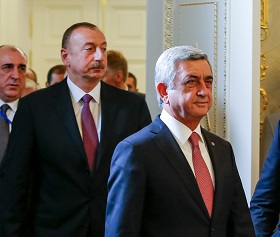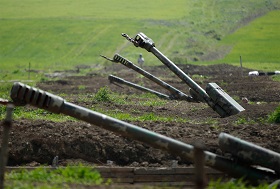The Azerbaijani armed forces staged a new subversion along the Northeastern part of Armenian-Azerbaijani international border on the early morning hours of December 29. Three Armenian soldiers are confirmed killed, while Azerbaijani Ministry of Defense spokesperson declined to comment the operation, nor published about losses — in a long-standing practice.
The Azerbaijani armed forces staged a new subversion along the Northeastern part of Armenian-Azerbaijani international border on the early morning hours of December 29. Three Armenian soldiers are confirmed killed, while Azerbaijani Ministry of Defense spokesperson declined to comment the operation, nor published about losses — in a long-standing practice.
In an official written statement, the Armenian Ministry of Defense alleged to have “irrefutable evidence” of the Azerbaijani incursion in its possession. Unverified sources claim up to seven Azerbaijani soldiers killed, including one body in the remaining in Armenian trenches. Azerbaijani Ministry of Defense denied these rumors in a rare official statement.
Armenian Foreign Ministry rushed to make a bold statement calling upon the OSCE Minsk Group Co-Chairs “to sober” Azerbaijani leadership, which “[had] lost sense of reality”. The CSTO Secretary General Nikolay Boryuzha released a statement expressing “serious concerns”. The statement also catered to the emotional needs of Armenian population by referring to Nagorno Karabakh as sovereign Republic.
The roots
The present escalation is neither unprecedented, nor has been unpredictable.
Steady escalation both along the Line of Contact between Azerbaijan and Nagorno Karabakh as well as the international border with Armenia could have been observed since 2010, at the peak of then Russian President Dmitry Medvedev’s peacemaking efforts — all vanished in Kazan Summit on June 24, 2011. Growth in military expenditures (from $1.7bln in 2010 to between $$3.2-3.7bln in 2011-2015 in Azerbaijan; and $$409-493mln in Armenia in 2009–2015, according to SIPRI database), blunt brinkmanship during “guns of August” and Armenian helicopter shoot down in November 2014, and overall intensity and changing nature of ceasefire violations — in the shadow of general stalemate in peace process since 2011 Kazan Summit and great power’s tolerance of creeping escalation — all these gave birth to the four-day war in April, 2016.
The present subversion is merely an echo of April war and result of disregarded post-war agreements.
After the Four Day War, the OSCE Minsk Group Co-Chairs held an emergency meeting in Vienna a month after the war (May 16, 2016) and Russian President Vladimir Putin convened a trilateral summit in Saint Petersburg on June 22 — yielding to agreements to establish international investigation mechanisms for ceasefire violations, which Azerbaijan was quick to condition with other steps, not reflected in the joint declarations.
On August 8 and 10 Vladimir Putin again hosted Ilham Aliyev and Serzh Sargsyan in two separate meeting slots — but no breakthrough was reported in the stalemate, except for expressing readiness to find compromise and work together in solving the “Karabakh knot”. Months later, Armenian President testified before Armenian intelligentsia on December 12 that the August 10 meeting “was the last serious conversation on Nagorno Karabakh thus far”.
The present
The December 29th operation by Azerbaijani military follows three episodes that unfolded in NK peace process in December.
First, on December 8 the Minsk Group co-chair countries’ Foreign Ministers issued a richly-worded joint statement at the OSCE Ministerial Council session, expressing concern over continuing armed incidents, strongly condemning threat of the use of force, and urging adherence to 1994/95 ceasefire agreements.
Second, at the annual CSTO get-together in Saint Petersburg on December 26 no decision was reached on a new Secretary General of the organization, to be assumed by Armenia’s nominee on a rotating basis. Earlier, this decision was delayed due to Kazakh President Nursultan Nazarbayev’s absence in Yerevan Summit in October, while now it was Alexander Lukashenko’s turn to be absent and derail decision-making. Both Nazarbayev and Lukashenko are widely considered to be Azerbaijani President Ilham Aliyev’s best men, despite the latter’s fraternal relations with local Armenian business tycoon.
On a larger agenda, this sent the credibility of the Kremlin-led CSTO to a new all-time-low at times of Russia’s increasing role in international arena, which Bordyuzha’s December 29 statement was aimed at saving.
And third in order, but not in terms of importance, former Armenian President Levon Ter-Petrosyan appeared before his party convention on December 17 and made a reverberating speech about the meaning of peace and open discourse in Armenia about the settlement plan he alleged was currently on the table, essentially echoing his own article published in September 1997, months before he would resign. This might have sent wrong signals to Baku and re-energised nationalist and populist sentiments in Armenia, and will likely run throughout parliamentary elections campaigns of a number of parties.
The future
The 2016 has been a decisive year for Nagorno Karabakh peace process in many aspects. Volumes of essays and news stories have been inked to explore what happened in April, some of it in a bid to feed the narratives in propaganda war, yet little attention indeed was paid to the reasons of this escalation. So long as the parties blame each other for “walking back” from agreed measures, and OSCE mediators reference their age-old mandate (adopted in 1995) to justify absence of position, the situation in Nagorno Karabakh will continue to spiral to another war, especially given the projections of shrinking oil exports and revenues from 2017 and onwards in Azerbaijan. The ruling elite in Baku has thus far (since 2005-06, when BTC went into operation) relied on vast oil revenues to legitimize their rule, in parallel to playing the “external enemy” card.
In a new situation of melting oil fund and shrinking revenues, the Karabakh card will be played more vigorously — as not the “settlement” (unless it’s win/lose) but the stalemate and controlled escalation will be the new and only lifebuoy of the elite in Azerbaijan, something that a number of key states shall rationally not be interested in, given the turmoil in the wider region.
Key parliamentary elections in Armenia will be held on April 2, 2017 — exactly a year after the ‘little war’, something that may likely envelop the entire campaign and make Armenia revisit its deterrence strategy.
One possible scenario for avoiding “the scourge of war” for Armenia is establishing unilateral mechanisms of incident detection and investigations under international watch, as Azerbaijan will hardly adhere to that unless escalation spirals too much out of control.
And that’s the puzzle we are entering the 2017 with.






